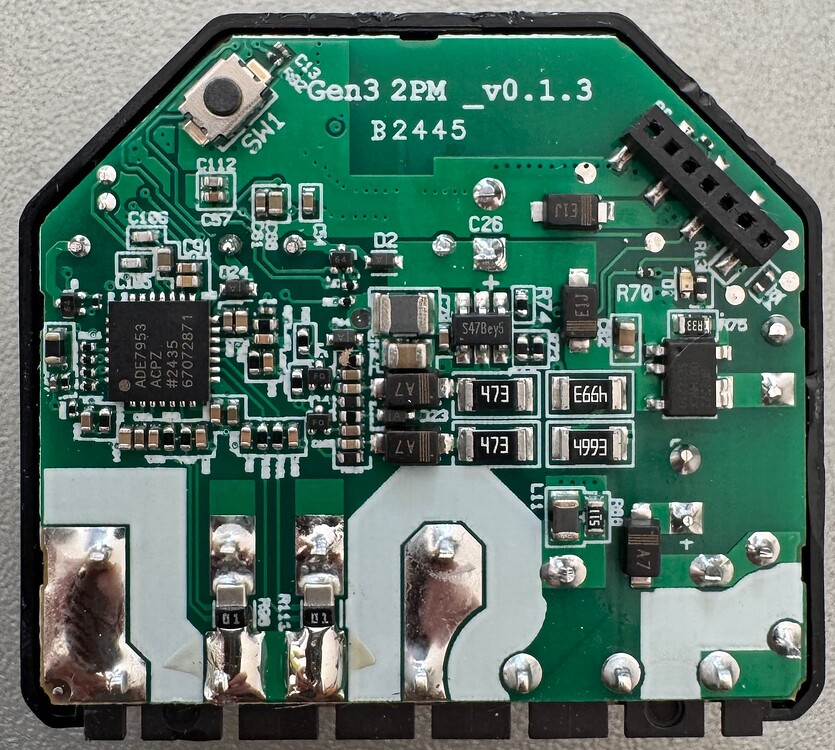Shelly 2 PM Gen3
Generation 3 of Shelly 2. With Powermeter.
Generation 3 configurations are not compatible with earlier Shelly 2 generation hardware.
General hardware info, including serial pinout is on the
Shelly Knowledgebase.
GPIO Pinout
| Pin | Function |
|---|---|
| GPIO0 | ASE7953 RST |
| GPIO1 | ADE7953 IRQ |
| GPIO2 | LedLink_i |
| GPIO3 | Relay 1 |
| GPIO4 | ADC Temp |
| GPIO5 | Relay 2 |
| GPIO6 | I2C SDA |
| GPIO7 | I2C SCL |
| GPIO10 | Switch 1 |
| GPIO18 | Switch 2 |
| GPIO19 | Reset Button |

These configurations may be flashable from the Shelly stock firmware OTA using mgos32-to-tasmota32, but was only tested via direct serial flash. OTA changes and upgrades after initial flash via ESPHome Web seem to work fine.
Basic Configuration
This will appear in Home Assistant as two relays linked to the switch inputs. This includes power and temperature monitoring of the I2C interfaces.
Most of this configuration was taken from this Home Assistant Community thread, and the work to figure out the GPIO pins is thanks to the Tasmota community.
substitutions:
device_name: shelly-2-pm-gen3
friendly_name: Shelly 2 PM Gen3
# Friendly name for each switch
channel_1_name: Switch 1
channel_2_name: Switch 2
max_power: "2000.0" # watt
max_temp: "70.0" # °C
restore_mode: RESTORE_DEFAULT_OFF
esphome:
name: ${device_name}
name_add_mac_suffix: false
friendly_name: ${friendly_name}
esp32:
variant: esp32c3
flash_size: 8MB
framework:
type: esp-idf
version: recommended
sdkconfig_options:
COMPILER_OPTIMIZATION_SIZE: y
# Enable logging
logger:
# Enable Home Assistant API
api:
encryption:
key: !secret api_enc
ota:
- platform: esphome
password: !secret ota_pwd
wifi:
ssid: !secret wifi_ssid
password: !secret wifi_password
ap:
ssid: "${friendly_name}"
password: !secret ap_pwd
captive_portal:
i2c:
sda: GPIO6
scl: GPIO7
sensor:
- platform: ade7953_i2c
irq_pin: GPIO1
voltage:
name: "Voltage"
id: voltage
icon: mdi:alpha-v-circle-outline
device_class: voltage
frequency:
name: "Frequency"
id: frequency
accuracy_decimals: 2
icon: mdi:cosine-wave
device_class: frequency
current_a:
name: ${channel_1_name} Current
id: channel_1_current
icon: mdi:alpha-a-circle-outline
device_class: current
current_b:
name: ${channel_2_name} Current
id: chanenl_2_current
icon: mdi:alpha-a-circle-outline
device_class: current
active_power_a:
name: ${channel_1_name} Power
id: channel_1_power
icon: mdi:power
device_class: power
filters:
- multiply: -1
active_power_b:
name: ${channel_2_name} Power
id: channel_2_power
icon: mdi:power
device_class: power
filters:
- multiply: -1
update_interval: 5s
# NTC Temperature
- platform: ntc
sensor: temp_resistance_reading
name: "Temperature"
id: temperature
icon: "mdi:thermometer"
calibration:
b_constant: 3350
reference_resistance: 10kOhm
reference_temperature: 298.15K
on_value:
then:
- if:
condition:
- sensor.in_range:
id: temperature
above: ${max_temp}
then:
- switch.turn_off:
id: shelly_relay_1
- switch.turn_off:
id: shelly_relay_2
- logger.log: "Switch turned off because temperature exceeded ${max_temp}°C"
- homeassistant.service:
service: persistent_notification.create
data:
title: Message from ${device_name}
data_template:
message: Switch turned off because temperature exceeded ${max_temp}°C
on_value_range:
- above: ${max_temp}
then:
- logger.log: "Temperature exceeded ${max_temp}°C"
- platform: resistance
id: temp_resistance_reading
sensor: temp_analog_reading
configuration: DOWNSTREAM
resistor: 32kOhm
- platform: adc
id: temp_analog_reading
pin: 4
status_led:
pin:
number: 2
inverted: true
ignore_strapping_warning: true
switch:
- platform: gpio
id: shelly_relay_1
name: ${channel_1_name} relay
pin:
number: 5
mode:
output: true
icon: "mdi:electric-switch"
restore_mode: ${restore_mode}
- platform: gpio
id: shelly_relay_2
name: ${channel_2_name} relay
pin:
number: 3
mode:
output: true
icon: "mdi:electric-switch"
restore_mode: ${restore_mode}
binary_sensor:
- platform: gpio
pin:
number: GPIO18
name: ${channel_1_name} input
id: channel1_input
# small delay to prevent bouncing
filters:
- delayed_on_off: 50ms
on_state:
then:
- logger.log: ${device_name} Switch State Changed.
- if:
condition:
binary_sensor.is_on: channel1_input
then:
- switch.turn_on: shelly_relay_1
else:
- switch.turn_off: shelly_relay_1
- platform: gpio
pin:
number: GPIO10
name: ${channel_2_name} input
id: channel2_input
# small delay to prevent bouncing
filters:
- delayed_on_off: 50ms
on_state:
then:
- logger.log: ${device_name} Switch State Changed.
- if:
condition:
binary_sensor.is_on: channel2_input
then:
- switch.turn_on: shelly_relay_2
else:
- switch.turn_off: shelly_relay_2
- platform: gpio
name: "Reset Button"
pin:
number: 19
inverted: yes
mode:
input: true
pullup: true